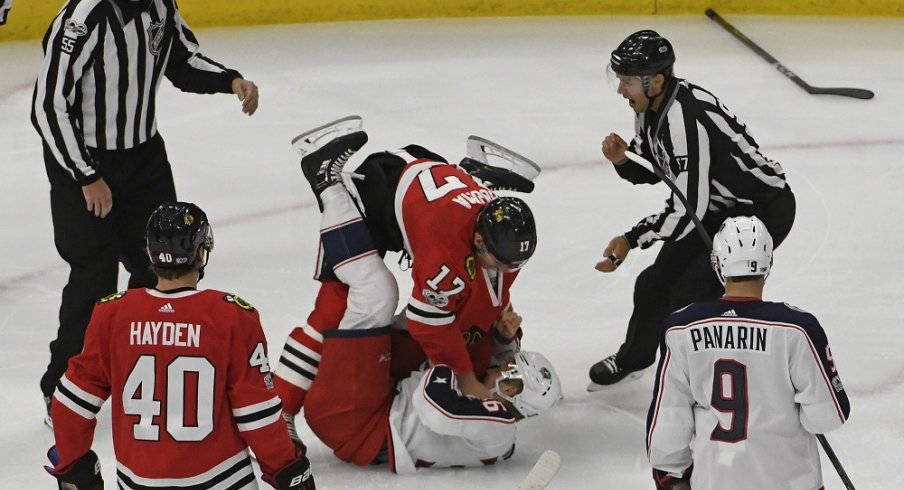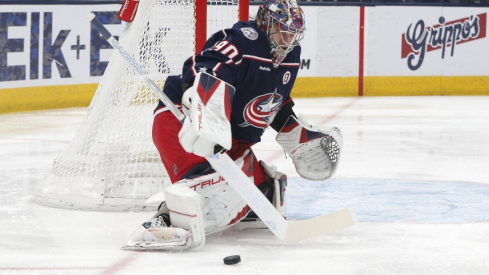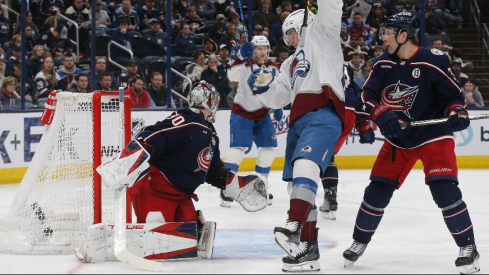If you’ve been watching Columbus Blue Jackets games this year, chances are you might have noticed something is missing.
You might like it. You might not. But there has been a lack of one very obvious facet of the game during the 2017-18 campaign.
Fighting.
Through 19 games on the season, the Blue Jackets have taken part in just three fights this season, or less than one fight every six games. Two were in the opening pair of games, as Matt Calvert squared off with the Islanders’ Johnny Boychuk in the first contest of the year and Zac Dalpe – trying to make whatever impact he could on the team – dropped the gloves against Chicago’s Lance Bouma a night later.
Then, a gap of nearly a month before Josh Anderson went at it with Boston’s Zdeno Chara on Oct. 30 (later in the game, Boston’s Kevan Miller dropped the gloves and went after Oliver Bjorkstrand after a questionable hit, but the Blue Jackets forward was not given a fighting major). In the month of November, the Jackets have been in zip, zilch, zero fights in seven games.
On the whole, the numbers are down this year compared to previous seasons for the Jackets. Last year, according to HockeyFights.com, the Jackets were in 22 fights, or one every 3.7 games. In 2015-16, the Jackets compiled 38 fights (one every 2.2 games), and they were at 44 in 2014-15 (one every 1.9 games).
This year, the team is on pace to take part in just 14 fights on the season.
At times since this site has launched, I’ve pointed out that John Tortorella isn’t the old-school, almost Neanderthal-like curmudgeon many characterize him to be. But on the subject of fighting, yes, it’s fair to say Tortorella isn’t a fan of what he now refers to as a gentleman’s game.
“The game has changed,” Tortorella said. “It has changed. ... But you need that. Now it’s a blocked shot. It’s a second effort on a backcheck. The fighting part of it to bring camaraderie has been taken out of our game. You need to find other things.
"It’s a great question because I think that’s very important for a hockey team is to rally around something in such a long year. In certain times during the year, you need to rally.”
As Tortorella pointed out – and as most hockey fans know – a fight can be much more than just competitive violence. It can be a momentum shifter, the kind of event that can not just unite a team but bow its back.
Consider Anderson’s bout with Chara in the Boston game. An imposing 6-foot-9 before the skates even go on, Chara is one of the most intimidating players in the game, but after taking a dangerous shot into the boards, Anderson saw no recourse other than dropping the gloves with the big defenseman.
Afterward, Tortorella couldn’t help but rave about Anderson’s actions.
"Not too many people would want to get involved in that," Tortorella said. "High marks (for Josh). You better get your first shot in, though, and he did, I think. So, good for him."
This isn’t the first time the Blue Jackets head coach has put a fair amount of stock in a player’s decision to fight. In last year’s New Year’s Eve showdown at Minnesota, back-to-back bouts featuring Anderson and Chris Stewart as well as Matt Calvert and Mathew Dumba left the team’s bench feeling “10 feet tall,” in the coach’s words, on the way to the team’s win.
As you've probably heard, the decrease in fighting is not just a Blue Jackets trend. According to HockeyFights.com (a perfect resource for this, right?), there are just 0.23 fights per game this year in the NHL, the lowest number since the site started tracking in 2000-01. It continues a long-discussed trend; in 2001-02, there were 0.65 fights per game, and 42.2 percent of all NHL games had at least one fight. This year, the number is 20.4 percent, and two teams – St. Louis and San Jose – have just one fighting major apiece on the season.
It’s not just the NHL that’s seeing the trend line. Even in the ECHL, a minor league long known for devolving into pugilism, the numbers are showing a slow but steady decline through the years.
I’m not going to go too deep into whether this is a good or bad thing. I’m perfectly fine attending a game without a fight – I’m here for the speed, skill and excitement of the sport – but I've always enjoyed a good bout, too. As for what the average fan thinks, I currently live in the city of Toledo, where fans of the ECHL's Walleye scream “Hit somebody!” during the final verse of the national anthem.
While no one seems to be asking for the days of “Slap Shot”-style violence, there’s an inherent attraction to watching when the competitive juices overflow a bit. At the same time, knowing what we know about head injuries now compared to what we knew even 10 years ago – and seeing their impacts on such players as Derek Boogaard – it’s totally reasonable to be a bit squeamish when the fists start flying.
But what is inarguable is, as Tortorella said, the game has changed and it must deal with the consequences. One of those is that teams and players must find different ways throughout a contest to change or create momentum.
It’s just another thing to think about as you spend your time watching Blue Jackets games this season.
Andy Man Can
Well, count me as someone who was wrong about the type of year Anderson is putting together.
I don't have to say anything here. I'm not sure I publicly declared anything about the kind of season I thought Anderson would have.
But I did think it, and I did talk to some of the 1st Ohio Battery guys about it, so I'll offer a mea culpa (I have no problem admitting when I'm wrong, after all). It wasn't anything to do with his contract holdout – though I guess that didn't help – just that fourth-round draft pick kind of came out of nowhere to have a 17-goal season last year as a rookie. I just expected some of the bounces and puck luck that went his way last year to go the other way this year.
I knew he was fast and played an aggressive, attacking game. I knew he had a quick, accurate shot capable of catching goaltenders by surprise. I just had a gut feeling it would be a down year, the kind that sometimes happens after a guy bursts onto the scene. After all, while he had been a fine player with the London Knights – on a team that was one of the most decorated and talented in Canadian junior hockey history – he wasn't the kind of can't miss offensive prospect who you just knew would translate to the NHL level.
But this year, his play has gone a long way to proving to me wrong. In fact, you could argue he's been as important to the cause as any Blue Jackets forward, scoring big goals and putting together what has turned out to be a tremendous package of skills into on-ice productivity.
So here's to Anderson, a player who not only didn't let the offseason noise (or in-season quips from his head coach) get to him, but who has proved he could be a key part of this team for quite a while.


